How do you support big ornamental grasses?
The downside to loving ornamental grasses is that some of them get BIG and flop all over the place and grow root balls that might as well be made from poured concrete.
Some of my miscanthus are at that stage now and I can't dig them out to divide them without renting a backhoe. So my choices are to divide them in place using a chain saw or an axe and hope I can dig out the pieces or just support them somehow.
This spring I tried what I think are called Double Peony Supports that I bought at my local special feed store. The supports have two rings of 18 inch diameter and the total height is 36 inches. They're too flimsy, but are a good start. Maybe I could double them up - double double peony supports? It's too dark out right now to photograph them, but maybe tomorrow if it's not raining
Anyway, I just ran into this thread that Mindy of Cotton Arbo-Retum fame posted last year on the Perennials Forum.
Mindy (arbo_retum)'s post on Y Stakes: Can't live without them!
This thread has lots of good ideas and I'm wondering if anyone here has anything to add or has good or bad experience with shoring up big floppy plants to share. I love the grasses but when they start flopping they overwhelm everything around them.
Claire
Comments (41)
Thyme2dig NH Zone 5
14 years agoHi Claire, I have a few of my grasses planted near my picket fence so I tie twine/jute around it to the fence. However that doesn't work very well for the really tall ones becaues then they want to flop above where they are tied. I've been struggling with a solution for a number of years with the large grasses.
One idea I've been toying with is getting 8' heavy copper tubing from my local hardware store and using that as stakes. I figured I could leave the copper tubes out all winter and they would patina and blend in with the grass during the growing season. That solution is pretty pricey though.
This year I noticed a shepherd's hook in the garden that we didn't have a bird feeder on. It was very tall and I thought maybe that would work. It was the kind that has the double-stake at the bottom of it. I tied the grass around in a couple places to it. It was very stable and did a great job keeping the grass from flopping. It was a Giant Chinese Silver Grass to give you an idea of the size of the grass I was dealing with.
I know you are a bird-lover so maybe you could use that idea and at the same time hang a birdfeeder on it. I only used it as a stake since it's in a perennial garden and I have found the black oil to kill my plants.
Susan
WendyB 5A/MA
14 years agoI have some double peony rings from Songsparrow.com (site seems to be down right now). They are definitely not flimsy. (well, at least the ones I bought several years ago. these things change...)
Maybe not big enough for a huge grass clump, but probably okay for most.
Related Professionals
Harvey Landscape Architects & Landscape Designers · Farmington Landscape Contractors · Riverhead Landscape Contractors · South Portland Landscape Contractors · West Orange Landscape Contractors · Westford Landscape Contractors · Greenfield Landscape Contractors · Elkridge Decks, Patios & Outdoor Enclosures · Ashland Decks, Patios & Outdoor Enclosures · Cary Decks, Patios & Outdoor Enclosures · Hull Decks, Patios & Outdoor Enclosures · Huntington Decks, Patios & Outdoor Enclosures · Los Alamitos Decks, Patios & Outdoor Enclosures · Racine Decks, Patios & Outdoor Enclosures · Westminster Decks, Patios & Outdoor Enclosuresclaireplymouth z6b coastal MA
Original Author14 years agoSusan: I love copper, but I'm not willing to pay for copper stakes. The shepherd's hook idea is nice, but the grasses are in the middle of perennial beds and refilling the feeders would mean almost daily tromping on the perennials. Not to mention spilled seeds growing all over.
Wendyb: The Peony Guards at Klehm's Song Sparrow look very sturdy but they're only 30 inches tall and would be only 2 ft tall when the legs are buried. Maybe a combination of these peony guards reinforced with Mindy's Y-stakes to extend the top would work.
I hadn't been to the Song Sparrow site for a while, but they always have nice stuff and I have some of their peonies from a while back. I was startled by thier pricing policy for the peony guards - rather than paying for shipping separately, they included shipping in the base price and have three different items for the same guards, but shipped to different regions. I spent a few befuddled minutes trying to figure out the difference between the different items, before I noticed the shipping site.
Claire
corunum z6 CT
14 years agoHi Claire,
I don't have grasses to support, but wondered if fiberglass 48" or 60" electric fence posts would work. The kind used for horses. You could run garden twine through the eyes (loops) in the posts and sort of lasso the grass. The posts run about $3-4 each and will last. Just an idea.Jane
claireplymouth z6b coastal MA
Original Author14 years agoInteresting possibility, Jane!
Fiberglass Electric Fence Posts
You could also run stretchy tape through the holes, if only the stretchy tape came in colors other than the very unnatural blue-green sold in all of the garden locales (does anyone know of a source of dark green or beige stretchy tape?).
Claire
claireplymouth z6b coastal MA
Original Author14 years agoI should have mentioned that the velcro tape might be good. This is the velcro tie that seems to be replacing the stretchy vinyl tape in stores.
I'm now trying out the velcro for tying up some climbing roses.
Claire
corunum z6 CT
14 years agoHow about using strips of cut-up panty hose? Works very well on tomatoes - doesn't cut the stalk and provides elasticity so the plant can move in the wind - and you can get a color to match your grass stalks.
Jane
corunum z6 CT
14 years agoNot sure why these kinds of questions get to me, but they usually do. OK, Claire, found Tan Polyethylene Shin Pad Tape 1" x 27 yards @ $1.68/roll. Hockey players use it for their shin guards. So, with fiberglass electric horse fence posts and hockey player elastic tape(close to the color of your grass) maybe you can girdle the grass for the winter. Don't think I'll get a better idea - good luck.
Jane
Here is a link that might be useful: Tapebrothers.com
claireplymouth z6b coastal MA
Original Author14 years agoI know you're a cat-lover, Jane, but you have some of the attributes of a terrier! (comment meant affectionately). You certainly grab hold of a problem and shake it until a good idea emerges.
Re panty hose: A good tool, and I've used it before for plants, and also in the past for cleaning dirty bicycle wheel hubs. I was hoping for a solution a little more elegant that wouldn't cause the neighbors to snicker, although I haven't ruled it out.
Re shin guard tape: Looks interesting - I can't tell from the site whether there's an adhesive on the back, which wouldn't be good. If no adhesive, the tape could be really useful.
Thanks for all the possibilities; I need to do some mulling over of ideas and maybe some exploratory shopping.
Claire
terrene
14 years agoHow do I support big floppy ornamental grasses? I don't! I got so sick of my 2 huge Miscanthus 'Variegatus' flopping all over the surrounding perennials that I gave them away to Ishareflowers and Jaydee this past Spring. One of them used to flop over the Sedum - and when the Sedum was blooming I could hear the buzzing of all the bees under the grass fronds (poor bees, they were much happier this year).
Of my other big grasses, the Miscanthus purpurascens, 'Gracillimus' and Calamagrostis hybrids are nice and upright. Panicum virgatum is nice and upright, but the Panicum amarum 'Dewey Blue' was kind of floppy (this is a native dune grass, so it literally grows in sand, so my sandiest soil was probably still too rich). Still I didn't do anything to support it.
One possible option - I have a couple rolls of nice rusty yard wire - that wire fencing with the 2" x 4" openings. Using wire cutters, you could cut a cylinder of it, of whatever height seems optimal - and surround the grass. If you leave pokey wire pieces along the edges you can poke those into the ground and complete the cylinder. The reason I like the rusty wire is because the rust color is very camouflage and is nearly invisible in the garden.
claireplymouth z6b coastal MA
Original Author14 years agoterrene: My problem grasses are also two huge Miscanthus 'Variegatus' that got away from me. I should have divided them back when they were more manageable, but I was naive and let them have their way. Now I'm having to deal with it, but I want to keep them - they look really nice next to roses.
Rusty wire would certainly be a good option color-wise, and the cylinder is a good way to contain the grass.
So many good ideas!
Thanks all,
ClaireAlice Johannen
14 years agoThere's a property in my neighborhood just FULL of giant grasses. They support them with bungee cords -- usually two of them hooked together to encircle the grasses. They're not hooked to a fence or anything. I chuckled the first time I saw it, but dang, it works. No floppage.
claireplymouth z6b coastal MA
Original Author14 years agoVERY interesting idea, alicepalace! Easy (and cheap) to try out. Might be a challenge finding bungee cords in landscape colors, but definitely worth a look.
Are the bungees very tight so the grasses are forced to be like upright columns, or can the cords be loose enough to allow a graceful shape without the cords sliding down? I'm sort of thinking of the problem with socks that have to be loose enough to stay up without cutting off circulation in the leg, and tight enough not to fall down.
Thanks,
Claireterrene
14 years agoBungee cords would probably work well, but they might not look so good...I used to tie some string around the Miscanthus 'Variegatus', which was better than nothing, but barely.
Claire, before I gave them away, I successfully dug out divisions of this grass without having to dig out the whole clump. Also, it didn't seem that bad to dig out the whole clump (although I didn't do the digging - ishare and Jaydee's H's did the digging). They are much more easily handled in mid-Spring after they're cut down.
claireplymouth z6b coastal MA
Original Author14 years agoTerrene: Last spring I tried to dig the whole clumps out, but the rootballs were too big (and I'm a very determined person). I managed to hack off a few divisions but barely made a dent in the grass. They had been cut down already so the rootballs were reachable. I've dug out and moved other smaller grasses with no problems.
I decided then to try supporting them and see what happens this year. In general I prefer not to stake anything, but I've learned to accept it for some plants. I'll revisit the problem next spring, i.e., stare at the grasses after I've cut them down, and decide whether to try some of the ideas presented here, or to go berserk with an axe. Or a combination of these.
Has anyone tried selective pruning to cut down the volume of the grass, hopefully minimizing the pressure to flop?
Claire
crnaskater
14 years agoAnyone remember the heavy tool advertised for taking out Yuccas? It came in 2 sizes.....I wish I had one now to take out the grass clumps....
I have cut off some grass starting out the outer rim in the spring to transplant...the micanthus ribbon grass. Would never recommend that plant again! It just keeps spreading! And one clump had the nasty yellow jacket nest in the middle. Several of my known clumpers over the years have died in the center no matter how I tried to tie them up. The weight is just so heavy when the diameter is wide.
claireplymouth z6b coastal MA
Original Author14 years agoTreeskate: I'd forgotten about that tool. I think it was the Weed Wrench.
There's a review of the Weed Wrench on that other site that cannot be mentioned, but if you google weed wrench you'll find it.
I don't even want to think about trying to remove a grass with a yellow jacket nest in the middle....
Claire
arbo_retum
14 years agoclaire, i just saw this thread today; wish you had emailed me. at any rate, it's the rebar that is the solution- rebar and y stakes (unfortntly the tallest ones are 4')together. The rebar stays permanently and rusts so you can't see it- behind the clump.Two rebars are needed( one for either side of the back) for the larger miscanthus clumps. You get them to cut the rebar at your local masonry supplies place (martignetti's in woburn for us).Rebar 'is' the steel bars that are used to reinforce concrete, and it comes in various diameters. I think we've used 1/2"? and next size smaller. You have to use a sledge hammer to drive it in . you want it to go into the ground about 2' (REALLY a cinch w/ our rocky new eng soil)and for our miscanthus strictus we have the rebar 5-6' above the ground. Then we use 1 or 2 4' Y stakes just in front of the clump- to connect w/ each other and the rebar.We haven't needed any supports for the misc. giganteus or floridulus. (Maybe we finally took our own advice and planted those in CRUMMY soil w/ no soaker hose near them.)
It's funny; my misc.strictus grow like gangbusters but the opposite is my exper. w/ my variegatus. it's been like that for 15 yrs. phooey.
Also, do NOT use a chain saw on a grass clump. WAAAAY dangerous and you'll ruin the saw. AXE is solution.and strong man wielding it. preferably the same strong man who sledge hammered the rebar into place! Plse tell us what ends up working for you.
Do you grow misc gigant or floridulus? if so, does yours lose strap leaves in windy weather? none of my other grasses do this but, after the storm of a few dys ago, there are leaf stalks all over the yard.....
best,
mindyclaireplymouth z6b coastal MA
Original Author14 years agomindy: My two problem M. variegatus are free-standing in the middle of a perennial/rose bed, so I can't hide rebar behind them, but I'll keep it in mind. Maybe the rebar would blend in with the adjacent roses (Blushing Knockout and regular Knockout).
For some reason, these grasses grow very well here, faster than any other miscanthuses. Not terribly tall, but they grow (and flop) wide. I think the 4 foot stakes would be tall enough, but maybe they would need rebar reinforcement.
The wintry NW winds rip some of the variegatus leaf stalks off and distribute them around the yard. I usually pick them up and stick them in the wisteria pseudo-standard support. None of my other grasses shed like the variegatus do.
I'm still contemplating, and beginning to try a few methods.
Thanks for the tips!
Claire
nandina
14 years agoClaire, whenever I have a garden problem to solve thoughts return to Japanese gardens visited over the years. Their garden solutions are up-front, inexpensive and very much in view using materials from the natural world. A dead branch here, a recyled piece of board there; none of which offend the eye.
May I suggest pounding two rebars opposite each other placed about 7" into the grass clump. Grass will grow covering rebar and as it grows snug a medium width hawser around all securing it to the rebar. Finish off the tying project with a very visible, attractive knot which may include an interesting piece of driftwood or whatever. With a bit of thought and 'tweaking' this idea perhaps you can solve your problem.
claireplymouth z6b coastal MA
Original Author14 years agoThanks, nandina. I like the idea of the Japanese approach where the solution is visible and doesn't offend the eye. The potential for eye offense has been bothering me, since my two floppers are in a very prominent location.
One thing that's been bothering me is what it would look like in the spring when I cut down the dead stalks and wait, and wait, and wait for the new green grass to grow up. Y-stakes and peony rings can be put away, but rebar is for forever (or at least a while). Upright rusty rebar isn't terribly attractive if exposed.
I'm now considering using a combination of rebar and Y-stakes and tape, but putting the rebars in a tripod/teepee formation driven into the clump. I do this for roses, using bamboo or green plastic stakes attached with cable ties. Somehow the tripod structure is visually appealing to me by itself. I even have some flying wind feathers I could attach to the tripod for tell-tales. I've used them on the wisteria in the winter.
I'm not sure, though, if the grass will grow neatly through the tripod.
If that works, then I could easily wrap tape or natural rope (found on the beach?) around the clump and fasten it to the tripod as needed as the grass grows, and judiciously apply a few Y-stakes later in the season. Hopefully the rebar tripod would form the major support against winds and floppage, and the Y-stakes and tape would be secondary.
Any thoughts?
A side question is just how short do you really have to cut Miscanthus? I've always cut them down to about 6 to 8 inches. What would happen if I left a foot or two of stubble - would it splay out or stay upright until it decomposes?
Claire
nandina
14 years agoClaire, hopefully your northern teenagers will not dream up a practice that our southern ones use in the dead of night. They travel around looking for large clumps of dried pampas grass near the road which they set on fire. Dangerous!
Does the rebar have to remain in the ground over the winter? Not too hard a job to install it again as the grass begins to sprout in spring. I do have a permanent support method in one garden and I 'cheat' during the winter to disguise it. The craft stores such as Hobby Lobby sell long strands of fake ivy. This I wrap around the support stakes securing with bits of green single wrap velcro. Even up close you would swear it was a living ivy topiary and the color does not fade for years. I use the same fake ivy over and over each winter. You might consider this method on a rebar tripod.
Down here we cut the grass back to about 15". Have never noticed any splaying problems.
claireplymouth z6b coastal MA
Original Author14 years agoSetting fire to grass!!! Reminds me of driving along the NJ turnpike and seeing the gas towers aflame, but I sure wouldn't want to see that in a residential neighborhood! Luckily, I live in a remote rural neighborhood, that even most of the Halloween trick-or-treaters avoid. Just 4 little kids plus three parents this year. I've got lots of left-over candy to eat (hee-hee).
The problem with removing and reinstalling rebar is that I also have some established peonies in that bed (nothing like overplanting when I started out), and I want to minimize tramping near the peonies. I like the idea of fake ivy, or maybe fake fall-colored leaves that I see around here.
15 inches would look a whole lot better than the crew-cut stubble we see around here. I'm going to try that.
Thanks,
Clairearbo_retum
14 years agonandina, that ivy thing is BRILLIANT. i once posted about les and monique(Ct. gardeneres) and their amazing solution to their chainlink fence eyesore (their neighbor's). They ordered online a lg number of fake xmas tree branches, and then wove them into the chain link. so much is planted in front of the fence that the genius solution plus the living plants make for an 'invisible' fence.
but just fyi,nandine, removing rebar that is driven w a sledgehammer 2'into the ground- is not really 'easy', much less possible!!
claire, i didn't realize it was just variegatus you had problems with. Mine always flops as well,, but the rebar w/ y stakes works well for mine.i DO think a major part of your problem is the good garden soil. "NEXT time"(!) plant your grasses in junk soil. you can also plant them in heavy plastic pots to keep them from expanding so readily. that's what we do with our variegated bamboo.
best,
mindyclaireplymouth z6b coastal MA
Original Author14 years agoMindy: you're right - planting variegatus next to well-fed roses and peonies was not a great idea (but they look really good together!) I have managed to move other variegatus into leaner soil and we'll see if they can control themselves better.
Yet another learning experience. Ah well, I do like challenges...
Claire
crnaskater
14 years agoExcuse my ignorance but what is the Y stake you all are talking about that can be placed with the rebar? Any picture?
Secondly, about the planting in a large plastic container.... do you use the large ones from the garden shop that have drainage holes in the bottom? If you already have a clump, could you possible slit the side (like a 12-14" deep pot) and bottom and spade it into the ground? Would this help spreading?
arbo_retum
14 years agotree, here's a descriptn and link. i buy mine in 10pks from walter nicke:
Product Description
GARDEN WORKS" ENGLISH Y- STAKES PLANT SUPPORTS Based on a simple, but unique concept-their arms bend to fit the individual staking needs of just about any leaning or fallen plant Each stake can be bent repeatedly into customized shapes for years of convenient use More versatile than ring or linking supports and easier to use than bamboo rods with string Made from sturdy, brown coated aluminum shafts and topped with green galvanized wire arms that are covered with green PVC for long life Provide a more natural look than copper or plastic alternatives Carded 4 Foot Unique garden stake that gives you more flexibility.Here is a link that might be useful: y stakes illustrations
crnaskater
14 years agoThanks for the info and link. Even at 4 ft tall, how far do you have to push them into the ground to be of help to grasses 5-6 ft tall? I can imagine some of mine would need 4-5 of them just to encircle the large clump. I tried once to use twine to encircle the clump but the weight just made the whole 'stalk' pitch over....
arbo_retum
14 years agotree, forgot to answ your oth questn.To work, i think you'd need to plant your plant IN the pot, not cut a pot to fit around it. whole point is that these AGGRESSIVE plants need controlling!! i've not tried this technique w/ ornamental tall grasses, just w/ variegated short 15" H bamboos.
Y stakes are not strong enough on their own to hold up a wet heavy lg. clump of tall ornamental grass. you have to have rebar in there as the main support and then y stakes as a supportive member to take the place of the string. Y stakes have a max horizontal reach of about 26-30" total per stake.
best,
mindyp.s.In your ID, plse add your location next to your zone. it saves those of us wanting to help- from having to ask you. and it makes your advice usable to others. Zone only refers to cold temp. lows, but summer temps and other conditions are equally important.
winstonsaxonsdad
14 years agoIts now spring and I also have the problem of flopping ornamental grasses. I have been told that I should "divide" them. I have also been advised that I should discard the center of the clump since it is probably dead and save the perimeter growth. Are there any special techniques for doing this? In the past I used an axe but it was pretty hard work. Any suggestions are welcome. I live in CT
prairiemoon2 z6b MA
14 years agowinston's dad, I have Pennisetums but not the large ones. I have a 'Hamelin' that has been planted in the same location for over 7 years now. It did get bald in the middle a few years back and I was dreading dividing it. I had heard that you could cut out the middle instead so that's what we did. We cut out the middle by going around the dead center with a sawzall and then digging out the top 3-4 inches of dead roots and added a good layer of com*post on top of the newly cleaned out middle. Last year the grass looked great having grown back into the center.
Here is a link that might be useful: Ornamental Grasses
hunt4carl
14 years agoMaybe I'm tempting fate, but of the two BIG grasses I grow, neither of them have ever been divided: the Miscanthus 'Morning Light' has been in place for eight years, and the Miscanthus 'Variegatus' has stayed put for 13 years. . .both of them are 3'+ wide at the base, and still strong in the center. Fortunately, I did my research in advance and knew just how robust they could be. . .so they each have plenty of room. Heaven help me if I ever DO have to divide them - as someone else suggested, it would take a back-hoe and/or dynamite !
M. 'Morning Light' needs NO staking at all. . .it is very self-sufficient; however, the M. 'Variegatus' tends to flop like crazy. . .I have had great luck supporting this massive plant using five or six, 4' rebar driven 1' into the ground. Then, heavy wire in a ring around the top of the rebar, and a second ring at about 2'. The whole apparatus has rusted up perfectly, and is scarcely noticeable early in the season. One year, I tried wrapping the posts with chicken wire which is the absolute BEST solution - unfortunately, it looks pretty awful for the first half of the season until the grass engulfs it.
Carl
claireplymouth z6b coastal MA
Original Author14 years agoMore interesting ideas from PM2 and Carl. Thanks!
That note about chicken wire leads me to wonder whether you could use a reasonably decorative wire fencing as a ring around the rebar. Something vinyl coated in a green or black color would probably be not too intrusive.
And what about a dollop of compost in the center to feed the faltering grass?
It's getting closer to the time to actually make a decision....
Claire
mad_gallica (z5 Eastern NY)
14 years agoLast year, I finally got around to dividing my miscanthus 'Sarabande'. I was dreading it, so let it go a few years longer than optimal, but it really wasn't that bad of a job.
The trick is that there is no reason to even try to dig the thing out in one piece. So attack it like a pie. The first piece is the hardest, but after that the pieces only have to be detached from one side of the clump.
claireplymouth z6b coastal MA
Original Author13 years agoAlright, I couldn't put it off any longer so I reread the thread, looked at the grasses, and faced certain aspects of reality, such as I have to do the work myself or pay someone else to do it.
I thought hard about pounding rebar into my rocky soil, and I looked at the two big, heavy, old sledgehammers in the tool shed, and I quickly lowered my standards. Maybe metal fence posts with the U-shaped channel would pound into the ground easier, slipping in between the rocks. And a discussion with a few guys at Home Depot introduced me to a mini-sledgehammer that's more my size.
So I ended up with a 28 inch vinyl-coated woven wire fence, attached to 3 ft fence posts pounded 1 foot into the ground so 2 feet remains above-ground. I placed the posts outside the grass clump to give them room to grow and also to let them spread out a bit at the top. It's all green, so in the winter I may have to do some camouflage such as nandina suggests. At least they sort of match the peony supports near them.
Tools
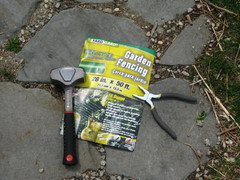
Grass Fence #1
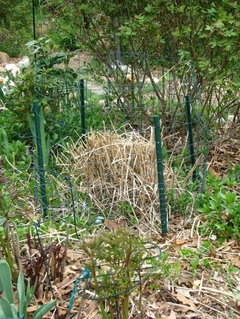
Grass Fence #2
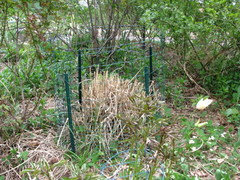
The wire fence fits nicely into the notches in the fence post and the flange footing should help keep it upright. I don't know if this is tall enough, but I plan to attach the 4 ft Y-stakes to the posts later in the season. I could fairly easily replace the 3 ft posts with 4 ft posts and just raise the fence.ex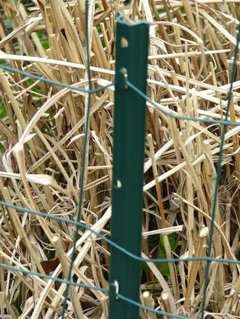
I used the loose ends of the fence to fasten the overlap. I also used some short black cable ties as fasteners.
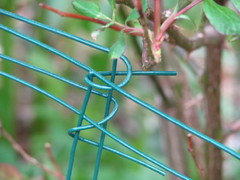
The operation was easier than I expected so it won't be so hard to talk myself into modifying the supports if I have to. I did manage to stomp on a few plants in the process, and working with curious, very thorny roses looking over your shoulder can be challenging.It's not very elegant and the green posts sort of annoy me, but it's a start. Now I have to wait and see if it works.
Claire
corunum z6 CT
13 years agoBy George, I think you've got 'em now, Claire! No way can he escape AND now that he's nicely corralled, next spring you can harvest the grass, sell it, and pay for the fencing. Lovely job and the effort to match the peony supports does not go unnoticed. A carefully enclosed miscanthus is a loved clump and the trampled tulips may be erect by morning.
(nice steel mallet, BTW)
Here is a link that might be useful: Miscanthus for Biofuel Production
claireplymouth z6b coastal MA
Original Author13 years agoThat's actually two separate caged grasses, both of them surrounded by peonies and roses. I hate to cage anything, but something had to be done.
Interesting article on miscanthus being better than switchgrass and corn for biofuel production. Not that I could send my very own grasses off to the slaughterhouse.
I also didn't know that miscanthus is closely related to sugar cane and will cross-breed with it. Maybe you could breed a sweet miscanthus that produces nectar for hummingbirds....
Claire
Richard Dollard
8 years agoI use these and just tie heavy rope/twine around them in the hooks.fence posts
claireplymouth z6b coastal MA thanked Richard Dollardclaireplymouth z6b coastal MA
Original Author8 years agoGood tips, jeffanderson11 and Richard Dollard. I'd pretty much given up on dividing the bigger monster grasses, not wanting to deal with a chain saw.
On the same principle as Richard's support, lately I've been using short shepherd's hooks and twine - anywhere from one to three hooks depending on the size and floppiness of the grass.
For this grass I used three hooks, equally spaced around the grass. This picture was taken this morning after two days of windy rain.

You can't see the twine now, but it's there.
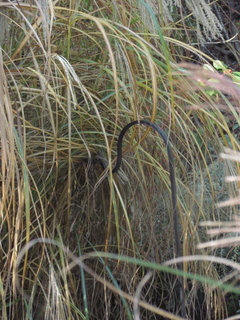
Claire
Babs Phillips
2 years agoNo, no, no! The best way to support these tall heavy grasses (because I have 20 of them in front of my house), I have discovered from desperation of trying everything else, is before they start growing in the spring, stick the largest, heavy-duty size tomato cages right in the middle of the pruned plant, pushing them as far down as they'll go to the first rung. As they grow in the middle and around the outsides of the cages, I then use plain ole string or a garden string, tying/securing one end at the back of the cage with a slip knot and wrap the string around the whole grass and tie it in the back of the cage. I leave the string at the 2nd end so I can tighten it or loosen it, whatever the plant needs. When it's super tall, you can use a couple of heights of string wrappings and also stick a garden stake (the bendable green kind in different sizes) right down the middle of the cage. Cages never show once the grass is tall. Works every year! Can't live without tomato cages!!!!
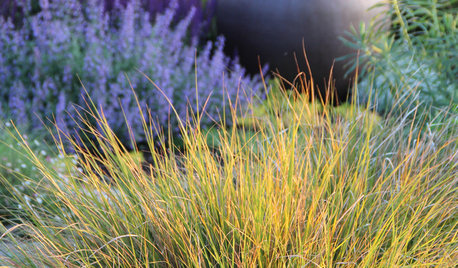
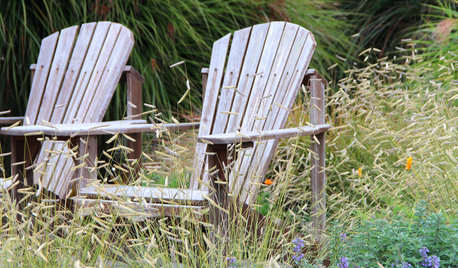
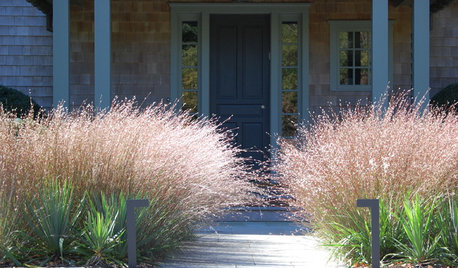

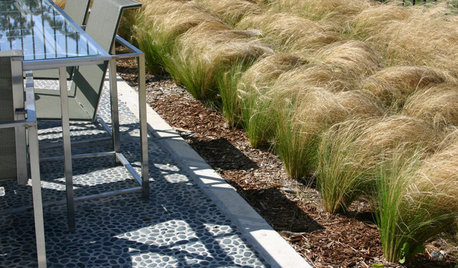
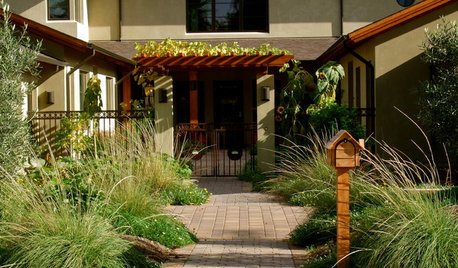
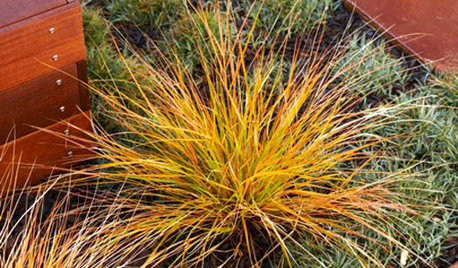
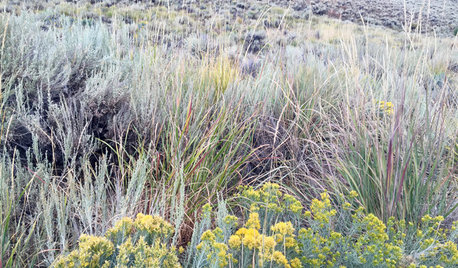
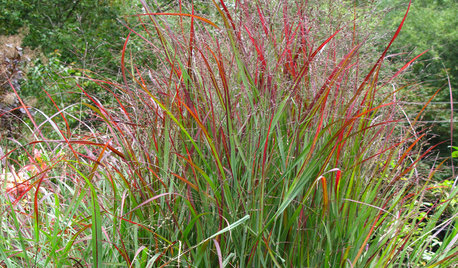









jeffanderson11